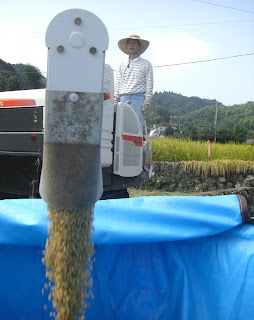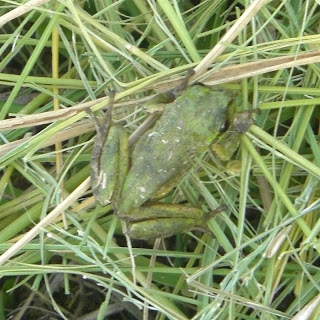Rika's family harvested their rice-fields on the 28-Aug. This was about a week too early in terms of maximising the rice yield, although early-harvested rice tastes better.
It turned out to be excellent timing in terms of weather. Saturday was a lovely day, but from Sunday a glancing blow from a typhoon brought heavy wind and rain, and many of the neighbors' rice was blown down.
This is the field before harvesting.
This is the first year I have participated in the rice harvest. Last year I was too busy at work (Lehmans collapse), and the previous year we were rained off, and the harvest was done later by a neighbour.
The first step is to cut the rice stalks from the corners of the field, to allow the combine harvester room to turn. Then the rest of the harvest can be done by driving the 'combine' round the field.
This is Ni-chan making the first circuit around the lower field with Nao-chan in the foreground.


Ni-chan driving the combine

The combine in action. It cuts 2 or 3 rows of rice-stalks at a time, with the spacings working out neatly because the rice stalks were originally planted by a machine made by the same company.
The rice stalks to the left are pushed out of the way by a metal bar. The target 2 or 3 rows are cut by the header and fed into a conveyor system which rotates them so that the heads feed into the thresher and the stalks are carried around the back.
The threshing mechanism of the combine. The chain in the foreground carries the straw to the back of the combine.

"threshing threshing drum, to which grooved steel bars are bolted. These bars thresh or separate the grains and chaff from the straw through the action of the drum against the concave, a shaped "half drum" through which grain, chaff and smaller debris may fall, whereas the straw, being too long, is carried through onto the straw walkers".

The chain carrier the waste straw to the back of the combine, where it is cut up by a row of cutters, and drops out the back of the combine onto the field.

The separated grain is stored in a tank behind the driver. When this is full it can be unloaded using a long pipe which has a rotating screw mechanism inside to move the grains up and along.

The grain is unloaded into a big bag, and when that is full it is taken to a factory where the grain is cleaned? and dried for a few days.
"The seeds of the rice plant are first milled using a rice huller to remove the chaff (the outer husks of the grain). At this point in the process, the product is called brown rice. The milling may be continued, removing the 'bran', i.e., the rest of the husk and the germ, thereby creating white rice. "

The combine is extremely efficient but it is also dangerous, and so it is covered with signs warning users of what could happen if they get careless.

The most dangerous operations are manually feeding the hand-cut stalks into the thresher (last video above), and driving the combine up and down slopes into the fields.

Ni-chan taught me how to drive the combine, and let me harvest some of the fields.



Thats the 2 lower fields harvested. This is BaBa arranging some stalks to dry. I think these are for some sort of decoration.

Next was the upper field. In total the 3 fields produce about 450kg of rice (15 x 30kg sacks). Although I'm not sure if these are sacks of rice with chaff, or brown rice, white rice or polished rice).

Thats the 3rd field done, just as the sun is setting.


The big bag almost full for the 2nd time.

Before the harvest, the fields of rice were home to lots of dragonflies, cicadas, grasshoppers, frogs. But they are all suddenly made homeless by the combine. As you cut each row the refugees tend to flee left among the remaining rice stalks. But when you mow down the last few rows they are all forced to jump out into the field.
Dragonflies hovering above the empty field.







That evening, Hannah found this frog on the vending machine near Baba's house. I wonder if its looking for a new home?


























